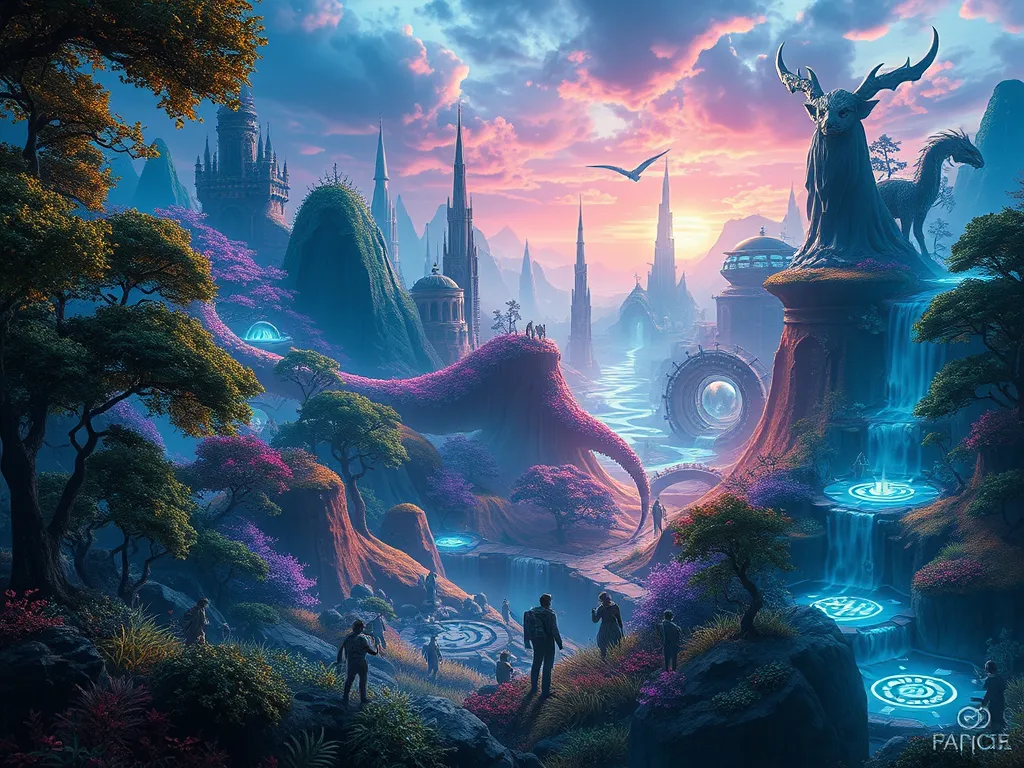Explore The Art of Interactive Storytelling in Modern Games

The Art of Interactive Storytelling in Modern Games
The Art of Interactive Storytelling in Modern Games represents a groundbreaking evolution in the way narratives are crafted and experienced by players. Unlike traditional storytelling, which relies on a linear structure and passive audience engagement, interactive storytelling integrates player choices and actions into the narrative fabric, creating unique story experiences. This dynamic allows players not only to witness a story unfold but to actively participate in its development, turning each gaming session into a personalized experience that can differ drastically from another player's journey.
At the heart of The Art of Interactive Storytelling in Modern Games is the idea that stories are not just told but lived. Players assume the roles of characters and navigate rich worlds that respond to their decisions, which adds layers of depth and engagement. These narratives are often constructed around complex themes, moral dilemmas, and character development that challenge players’ perspectives and foster a deeper emotional connection to the game. As a result, players are more invested in the outcomes of their actions, making choices that resonate with their values and beliefs.
The Art of Interactive Storytelling in Modern Games has also seen substantial technological advancements that enhance narrative delivery. High-quality graphics, immersive sound design, and innovative gameplay mechanics contribute to a more engaging storytelling experience. Furthermore, the rise of digital distribution platforms has allowed indie developers to explore unique storytelling techniques, leading to a diverse range of narratives that further enrich the gaming landscape. Ultimately, The Art of Interactive Storytelling in Modern Games reflects the diverse storytelling possibilities enabled by emergent technologies and player engagement.
As the industry evolves, so do the expectations of players. Gamers today seek out narratives that are not only compelling but also provide agency and meaningful choices. This shift has led to an exploration of various narrative structures, such as non-linear narratives and branching storylines, which allow for unique player experiences. In this context, interactive storytelling acts as a bridge between the game and the player, fostering a bi-directional relationship that enhances storytelling potential.
In summary, The Art of Interactive Storytelling in Modern Games is a complex and multifaceted domain that blends narrative sophistication with player agency. It cultivates emotional investment, prompts moral inquiries, and embraces technological advancements. As gaming continues to mature as an artistic medium, the stories it tells become richer, more engaging, and increasingly impactful on the players who experience them.
The Evolution of Interactive Storytelling
The Evolution of Interactive Storytelling traces its roots back to the early days of video gaming, where narratives were often simplistic and served mainly as a means to justify gameplay mechanics. However, significant milestones such as the emergence of text-based adventure games in the 1970s and 1980s, which invited players to make choices that impacted the outcomes, laid the groundwork for more complex storytelling. The introduction of multi-ending narratives in games like 'Zork' and later titles such as 'Final Fantasy VII' and 'The Legend of Zelda: Ocarina of Time' showcased the potential for interactive narratives, paving the way for a new era of storytelling in games.
Unlike traditional media, where the audience passively consumes content, interactive storytelling engages players in the narrative process. This comparative analysis of traditional vs. interactive media highlights how player agency transforms storytelling. In interactive games, players’ decisions create ramifications within the narrative, often leading to varied outcomes that reflect their unique experiences. Traditional media, in contrast, delivers a fixed story that unfolds in a predetermined way, creating less opportunity for individual engagement and interpretation.
Several key games have defined the evolution of interactive storytelling, showcasing innovative approaches that push the boundaries of narrative design. Titles like 'Mass Effect,' 'The Witcher 3: Wild Hunt,' and 'Life is Strange' each brought forth unique narratives that responded dramatically to player choices, fostering distinct emotional resonance and replayability. Such games have become cornerstones of interactive storytelling, serving as benchmarks for future developments in narrative-focused game design.
The evolution of digital media has transformed how we connect with narratives, exemplified by the engaging nature of Interactive Storytelling.
Character Development in Interactive Games
Character Development in Interactive Games utilizes various techniques to create relatable and multi-dimensional characters. Game developers focus on crafting rich backstories, strong motivations, and dynamic character arcs that allow players to connect deeply with the characters. Mechanisms such as dialogue trees and moral choices enable players to shape characters’ personalities and relationships, enhancing emotional investment. This depth prompts players to reflect on their in-game decisions, often viewing characters not just as avatars but as companions in an evolving story.
The impact of player choices on character arcs is a defining element of interactive storytelling. Unlike traditional narratives, where character development follows a set path, interactive games allow players to influence the direction of character development. This autonomy fosters connections between players and characters, as players feel responsible for the characters’ fates. Games like 'The Walking Dead' and 'Detroit: Become Human' exemplify how players’ decisions can lead to divergent character arcs, creating compelling stories that resonate with the choices made.
Memorable game characters often serve as a testament to effective character development techniques. Characters like Geralt of Rivia from 'The Witcher 3: Wild Hunt,' Ellie's evolution in 'The Last of Us,' and Max Caulfield in 'Life is Strange' have captivated players through their intricate personalities and emotionally charged journeys. These characters not only drive narrative engagement but also prompt reflection on broader themes such as loss, identity, and the consequences of choices, resulting in a lasting impact that transcends gameplay.
Narrative Structures in Modern Games
Narrative Structures in Modern Games often embrace non-linear techniques, allowing for a more immersive storytelling experience. Non-linear narratives present players with a web of choices and consequences, creating complex stories that diverge based on player decisions. This structure invites exploration and experimentation, as players engage with different story paths and outcomes, enhancing replayability and fostering deeper engagement with the game world and its narrative.
Player agency is a crucial element of storytelling in modern games. The ability for players to make choices that impact narrative outcomes empowers them to steer their own paths within the game. This agency invites players to become co-authors of the story, leading to diverse interpretations of events and themes. Games like 'Bioshock' and 'The Stanley Parable' challenge players to confront moral dilemmas tied to their choices, enhancing the significance of player agency within the narrative framework.
Examples of branching story paths in popular games illustrate how narrative structures have evolved. Games such as 'Mass Effect' series, 'Detroit: Become Human,' and 'Until Dawn' offer players multiple avenues and endings based on their choices. Such systems immerse players in the narrative, providing a sense of ownership over the story while demonstrating the potential for divergent storytelling in interactive media.
Emotional Engagement through Gameplay
Emotional Engagement through Gameplay is a hallmark of effective interactive storytelling. Mechanics that foster emotional responses include branching narratives, character relationships, and morally complex choices that challenge players' beliefs. Games often use significant moments of tension, joy, or loss to evoke strong feelings, allowing players to build connections to the story and characters. This emotional investment transforms gameplay into a resonant experience that captivates and engages players.
The psychology of storytelling in games leverages concepts like empathy and narrative transportation to deepen emotional engagement. By placing players in the shoes of characters facing dilemmas or challenges, games can elicit empathy, drawing players into the narrative. This psychological involvement is heightened in games with emotional weight, as players navigate complex themes tied to identity, morality, and consequence.
Examples of games that evoke strong player emotions appear across various genres. Titles like 'The Last of Us,' 'Hellblade: Senua's Sacrifice,' and 'Journey' demonstrate how gameplay can be intertwined with emotional storytelling, creating unforgettable moments that linger long after the game ends. These experiences exemplify how the art of interactive storytelling can resonate with players on a profound level.
The Role of Technology in Storytelling
The Role of Technology in Storytelling has greatly influenced how narratives are crafted and presented in modern games. Advances in graphics and sound enable developers to create visually stunning and audibly immersive worlds that enhance the storytelling experience. High-definition graphics can bring characters and settings to life, while sound design elements, including musical scores and voice acting, help build emotional depth, setting the tone for various narrative beats.
The use of VR for immersive storytelling represents a new frontier in interactive narratives. Virtual reality technology offers players an unprecedented opportunity to engage with stories as if they were part of the world. Games like 'Half-Life: Alyx' and 'Beat Saber' showcase how VR can create a sense of presence, allowing players to interact with narratives in a more personal and engaged manner, revolutionizing the interactive storytelling landscape.
Looking to the future, emerging technologies such as AI, AR, and machine learning are poised to shape interactive narratives. These technologies can create responsive and dynamic storytelling experiences that adapt to player actions, preferences, and emotions. As the gaming landscape continues to evolve, the fusion of technology and storytelling promises to unlock new dimensions of interactive narrative that captivate players and redefine engagement.
Cultural Representation in Game Narratives
Cultural Representation in Game Narratives highlights the significance of diverse narratives in gaming as the industry matures. Embracing a wide range of cultural perspectives equips games with richer and more relevant stories that resonate with a global audience. By exploring themes that reflect different cultures, games promote inclusivity and broaden players’ understanding of diverse worldviews, which is essential in today’s varied gaming community.
Examples of culturally rich storytelling can be seen in games like 'Celeste,' which addresses themes of mental health within the context of the protagonist’s journey, and 'Ghost of Tsushima,' which celebrates Japanese culture and history. Such games demonstrate how cultural narratives can be thoughtfully integrated into interactive storytelling, creating a deeper connection between players and the worlds they inhabit.
Analyzing the impact of representation on gameplay reveals how narratives rooted in authentic cultural experiences can influence player engagement and emotional connections. When players encounter characters and stories that reflect their identities, they are more likely to invest emotionally in the game. This representation fosters a sense of belonging in the gaming community, reinforcing the importance of inclusivity in interactive storytelling.
